computer RENAULT FLUENCE Z.E. 2012 Owners Manual
[x] Cancel search | Manufacturer: RENAULT, Model Year: 2012, Model line: FLUENCE Z.E., Model: RENAULT FLUENCE Z.E. 2012Pages: 195, PDF Size: 5.23 MB
Page 6 of 195
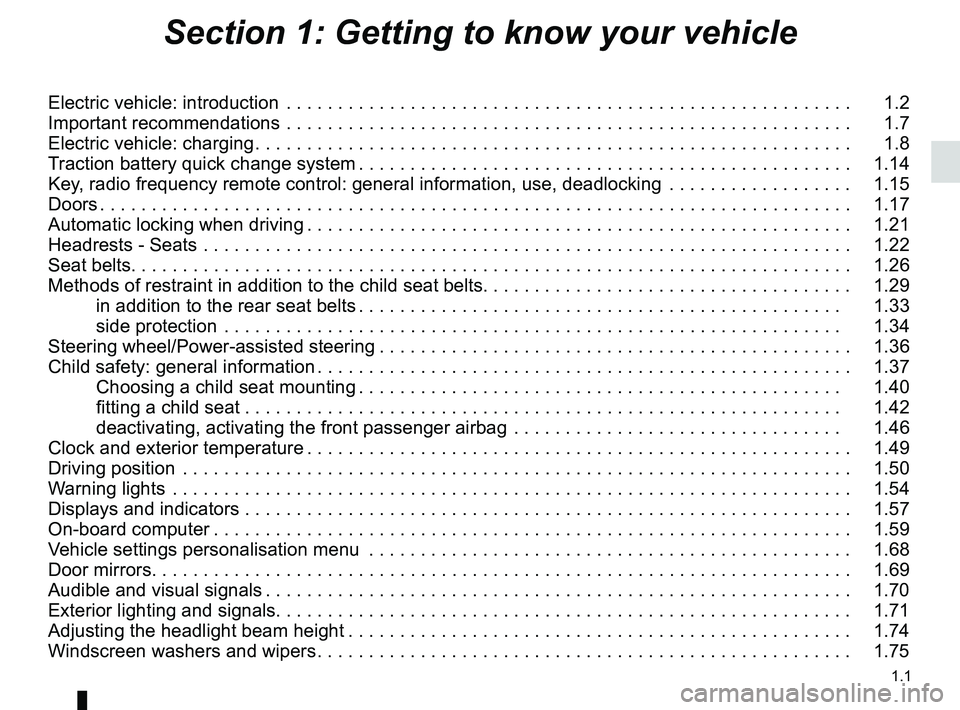
1.1
ENG_UD29436_4
Sommaire 1 (L38 - X38 - Renault)
ENG_NU_914-4_L38e_Renault_1
Section 1: Getting to know your vehicle
Electric vehicle: introduction . . . . . . . . . . . . . . . . . . . . . . . . . . . . . . . . . . . . . . . . . . . . . . . . . . . . . . . 1.2
Important recommendations . . . . . . . . . . . . . . . . . . . . . . . . . . . . . . . . . . . . . . . . . . . . . . . . . . . . . . . 1.7
Electric vehicle: charging . . . . . . . . . . . . . . . . . . . . . . . . . . . . . . . . . . . . . . . . . . . . . . . . . . . . . . . . . . 1.8
Traction battery quick change system . . . . . . . . . . . . . . . . . . . . . . . . . . . . . . . . . . . . . . . . . . . . . . . . 1.14
Key, radio frequency remote control: general information, use, deadlocking . . . . . . . . . . . . . . . . . . 1.15
Doors . . . . . . . . . . . . . . . . . . . . . . . . . . . . . . . . . . . . . . . . . . . . . . . . . . . . . . . . . . . . . . . . . . . . . . . . . 1.17
Automatic locking when driving . . . . . . . . . . . . . . . . . . . . . . . . . . . . . . . . . . . . . . . . . . . . . . . . . . . . . 1.21
Headrests - Seats . . . . . . . . . . . . . . . . . . . . . . . . . . . . . . . . . . . . . . . . . . . . . . . . . . . . . . . . . . . . . . . 1.22
Seat belts . . . . . . . . . . . . . . . . . . . . . . . . . . . . . . . . . . . . \
. . . . . . . . . . . . . . . . . . . . . . . . . . . . . . . . . . 1.26
Methods of restraint in addition to the child seat belts . . . . . . . . . . . . . . . . . . . . . . . . . . . . . . . . . . . . 1.29
in addition to the rear seat belts . . . . . . . . . . . . . . . . . . . . . . . . . . . . . . . . . . . . . . . . . . . . . . . 1.33
side protection . . . . . . . . . . . . . . . . . . . . . . . . . . . . . . . . . . . . . . . . . . . . . . . . . . . . . . . . . . . . 1.34
Steering wheel/Power-assisted steering . . . . . . . . . . . . . . . . . . . . . . . . . . . . . . . . . . . . . . . . . . . . . . 1.36
Child safety: general information . . . . . . . . . . . . . . . . . . . . . . . . . . . . . . . . . . . . . . . . . . . . . . . . . . . . 1.37
Choosing a child seat mounting . . . . . . . . . . . . . . . . . . . . . . . . . . . . . . . . . . . . . . . . . . . . . . . 1.40
fitting a child seat . . . . . . . . . . . . . . . . . . . . . . . . . . . . . . . . . . . . . . . . . . . . . . . . . . . . . . . . . . 1.42
deactivating, activating the front passenger airbag . . . . . . . . . . . . . . . . . . . . . . . . . . . . . . . . 1.46
Clock and exterior temperature . . . . . . . . . . . . . . . . . . . . . . . . . . . . . . . . . . . . . . . . . . . . . . . . . . . . . 1.49
Driving position . . . . . . . . . . . . . . . . . . . . . . . . . . . . . . . . . . . . . . . . . . . . . . . . . . . . . . . . . . . . . . . . . 1.50
Warning lights . . . . . . . . . . . . . . . . . . . . . . . . . . . . . . . . . . . . . . . . . . . . . . . . . . . . . . . . . . . . . . . . . . 1.54
Displays and indicators . . . . . . . . . . . . . . . . . . . . . . . . . . . . . . . . . . . . . . . . . . . . . . . . . . . . . . . . . . . 1.57
On-board computer . . . . . . . . . . . . . . . . . . . . . . . . . . . . . . . . . . . . . . . . . . . . . . . . . . . . . . . . . . . . . . 1.59
Vehicle settings personalisation menu . . . . . . . . . . . . . . . . . . . . . . . . . . . . . . . . . . . . . . . . . . . . . . . 1.68
Door mirrors . . . . . . . . . . . . . . . . . . . . . . . . . . . . . . . . . . . . . . . . . . . . . . . . . . . . . . . . . . . . . . . . . . . . 1.69
Audible and visual signals . . . . . . . . . . . . . . . . . . . . . . . . . . . . . . . . . . . . . . . . . . . . . . . . . . . . . . . . . 1.70
Exterior lighting and signals . . . . . . . . . . . . . . . . . . . . . . . . . . . . . . . . . . . . \
. . . . . . . . . . . . . . . . . . . . 1.71
Adjusting the headlight beam height . . . . . . . . . . . . . . . . . . . . . . . . . . . . . . . . . . . . . . . . . . . . . . . . . 1.74
Windscreen washers and wipers . . . . . . . . . . . . . . . . . . . . . . . . . . . . . . . . . . . . . . . . . . . . . . . . . . . . 1.75
Page 34 of 195
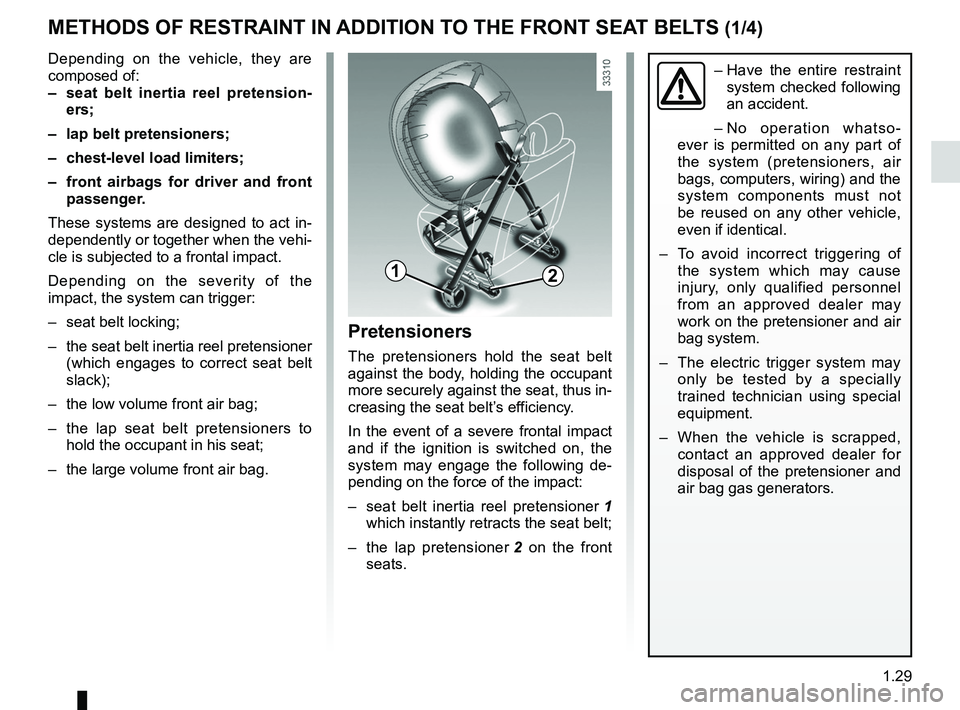
seat belts .............................................. (up to the end of the DU)
additional methods of restraint ............. (up to the end of the DU)
additional methods of restraint to the front seat belts ......................(up to the end of the DU)
additional methods of restraint to the rear seat belts .......................(up to the end of the DU)
air bag ................................................... (up to the end of the DU)
air bag ................................................... (up to the end of the DU)
pretensioners ........................................ (up to the end of the DU)
seat belt pretensioners front seat belt .................................. (up to the end of the DU)
seat belt pretensioners ......................... (up to the end of the DU)
methods of restraint in addition to the seat belts
(up to the end of the DU)
1.29
ENG_UD23032_2
Dispositifs complémentaires à la ceinture avant (L38 électriqu\
e - Renault)
ENG_NU_914-4_L38e_Renault_1
Methods of restraint in addition to the child seat belts
methODS OF reStrAiNt iN ADDitiON t O the FrONt SeAt BeltS (1/4)
Depending on the vehicle, they are
composed of:
– seat belt inertia reel pretension -
ers;
– lap belt pretensioners;
– chest-level load limiters;
– front airbags for driver and front
passenger.
These systems are designed to act in-
dependently or together when the vehi-
cle is subjected to a frontal impact.
Depending on the severity of the
impact, the system can trigger:
– seat belt locking;
– the seat belt inertia reel pretensioner
(which engages to correct seat belt
slack);
– the low volume front air bag;
– the lap seat belt pretensioners to
hold the occupant in his seat;
– the large volume front air bag.
Pretensioners
The pretensioners hold the seat belt
against the body, holding the occupant
more securely against the seat, thus in-
creasing the seat belt’s efficiency.
In the event of a severe frontal impact
and if the ignition is switched on, the
system may engage the following de -
pending on the force of the impact:
– seat belt inertia reel pretensioner 1
which instantly retracts the seat belt;
– the lap pretensioner 2 on the front
seats.
– Have the entire restraint
system checked following
an accident.
– No operation whatso -
ever is permitted on any part of
the system (pretensioners, air
bags, computers, wiring) and the
system components must not
be reused on any other vehicle,
even if identical.
– To avoid incorrect triggering of
the system which may cause
injury, only qualified personnel
from an approved dealer may
work on the pretensioner and air
bag system.
– The electric trigger system may
only be tested by a specially
trained technician using special
equipment.
– When the vehicle is scrapped,
contact an approved dealer for
disposal of the pretensioner and
air bag gas generators.
12
Page 40 of 195
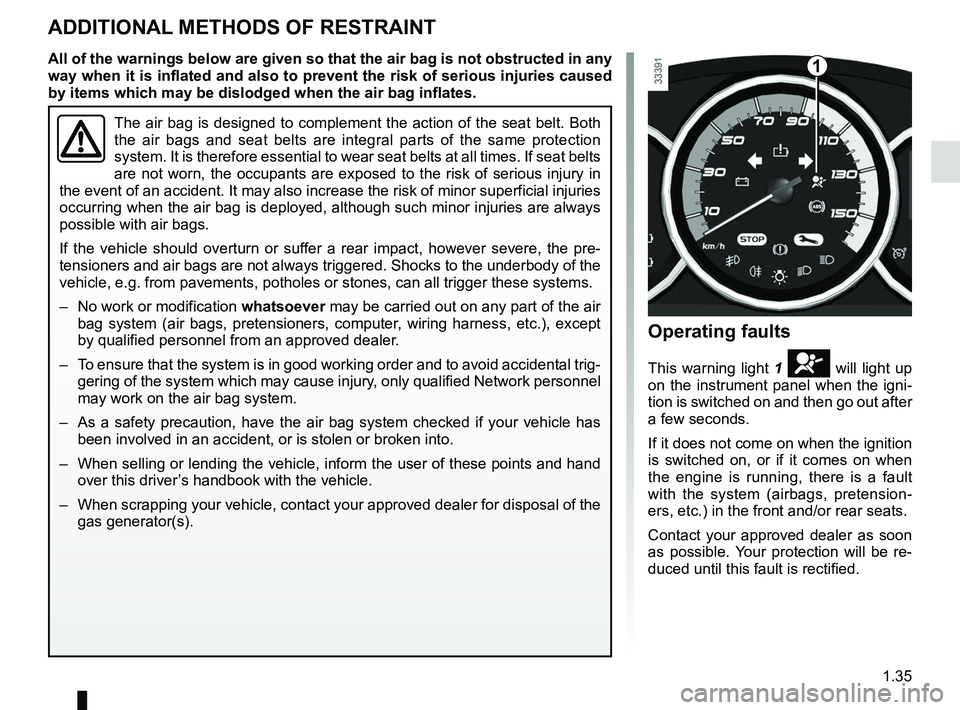
air bag................................................... (up to the end of the DU)
methods of restraint in addition to the seat belts
(up to the end of the DU)
additional methods of restraint ............. (up to the end of the DU)
seat belts .............................................. (up to the end of the DU)
air bag ................................................... (up to the end of the DU)
1.35
ENG_UD23682_2
Dispositifs de retenue complémentaire (L38 - X38 - Renault)
ENG_NU_914-4_L38e_Renault_1
ADDitiONAl methODS OF reStrAiNt
The air bag is designed to complement the action of the seat belt. Both
the air bags and seat belts are integral parts of the same protection
system. It is therefore essential to wear seat belts at all times. If seat belts
are not worn, the occupants are exposed to the risk of serious injury in
the event of an accident. It may also increase the risk of minor superficial injuries
occurring when the air bag is deployed, although such minor injuries are always
possible with air bags.
If the vehicle should overturn or suffer a rear impact, however severe, the pre-
tensioners and air bags are not always triggered. Shocks to the underbody of the
vehicle, e.g. from pavements, potholes or stones, can all trigger these \
systems.
– No work or modification whatsoever may be carried out on any part of the air
bag system (air bags, pretensioners, computer, wiring harness, etc.), except
by qualified personnel from an approved dealer.
– To ensure that the system is in good working order and to avoid accidental trig-
gering of the system which may cause injury, only qualified Network personnel
may work on the air bag system.
– As a safety precaution, have the air bag system checked if your vehicle has
been involved in an accident, or is stolen or broken into.
– When selling or lending the vehicle, inform the user of these points and hand
over this driver’s handbook with the vehicle.
– When scrapping your vehicle, contact your approved dealer for disposal of the
gas generator(s).
Operating faults
This warning light 1 å will light up
on the instrument panel when the igni -
tion is switched on and then go out after
a few seconds.
If it does not come on when the ignition
is switched on, or if it comes on when
the engine is running, there is a fault
with the system (airbags, pretension -
ers, etc.) in the front and/or rear seats.
Contact your approved dealer as soon
as possible. Your protection will be re-
duced until this fault is rectified.
1All of the warnings below are given so that the air bag is not obstructed in any
way when it is inflated and also to prevent the risk of serious injuries caused
by items which may be dislodged when the air bag inflates.
Page 56 of 195
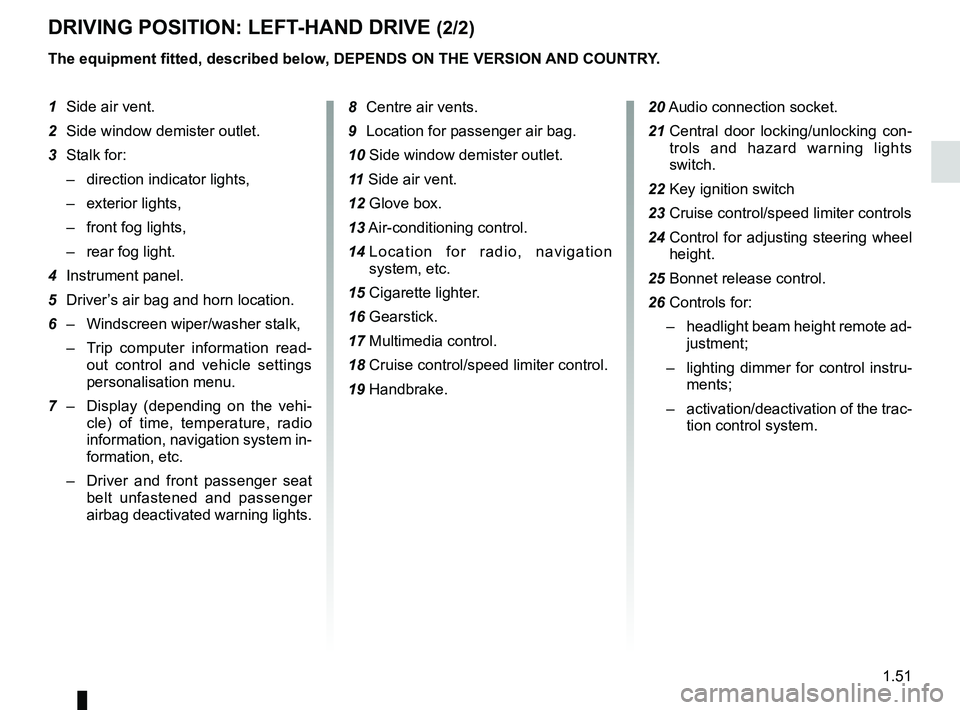
JauneNoirNoir texte
1.51
ENG_UD23033_2
Poste de conduite à gauche (L38 électrique - Renault)
ENG_NU_914-4_L38e_Renault_1
DriviNg POSitiON: leFt-hAND Drive (2/2)
the equipment fitted, described below, DePeNDS ON the verSiON AND cOUNtr Y.
1 Side air vent.
2 Side window demister outlet.
3 Stalk for:
– direction indicator lights,
– exterior lights,
– front fog lights,
– rear fog light.
4 Instrument panel.
5 Driver’s air bag and horn location.
6 – Windscreen wiper/washer stalk,
– Trip computer information read -
out control and vehicle settings
personalisation menu.
7 – Display (depending on the vehi -
cle) of time, temperature, radio
information, navigation system in-
formation, etc.
– Driver and front passenger seat
belt unfastened and passenger
airbag deactivated warning lights. 8
Centre air vents.
9 Location for passenger air bag.
10 Side window demister outlet.
11 Side air vent.
12 Glove box.
13 Air-conditioning control.
14 Location for radio, navigation
system, etc.
15 Cigarette lighter.
16 Gearstick.
17 Multimedia control.
18 Cruise control/speed limiter control.
19 Handbrake. 20
Audio connection socket.
21 Central door locking/unlocking con -
trols and hazard warning lights
switch.
22 Key ignition switch
23 Cruise control/speed limiter controls
24 Control for adjusting steering wheel
height.
25 Bonnet release control.
26 Controls for:
– headlight beam height remote ad-
justment;
– lighting dimmer for control instru-
ments;
– activation/deactivation of the trac-
tion control system.
Page 58 of 195
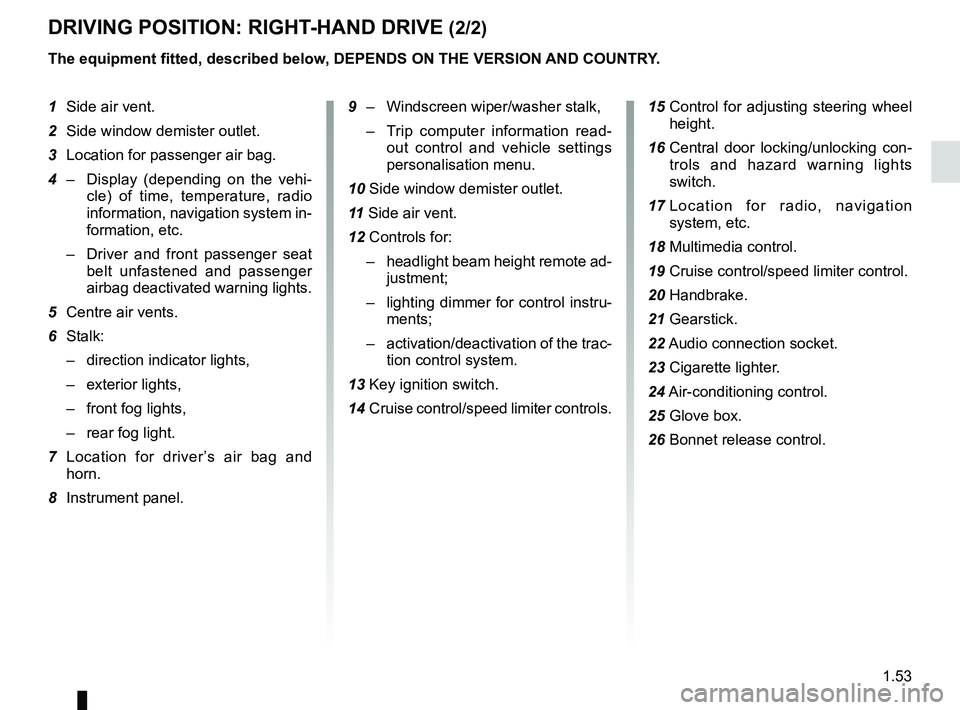
JauneNoirNoir texte
1.53
ENG_UD23034_2
Poste de conduite à droite (L38 électrique - Renault)
ENG_NU_914-4_L38e_Renault_1
DriviNg POSitiON: right-hAND Drive (2/2)
the equipment fitted, described below, DePeNDS ON the verSiON AND cOUNtr Y.
1 Side air vent.
2 Side window demister outlet.
3 Location for passenger air bag.
4 – Display (depending on the vehi -
cle) of time, temperature, radio
information, navigation system in-
formation, etc.
– Driver and front passenger seat
belt unfastened and passenger
airbag deactivated warning lights.
5 Centre air vents.
6 Stalk:
– direction indicator lights,
– exterior lights,
– front fog lights,
– rear fog light.
7 Location for driver ’s air bag and
horn.
8 Instrument panel.
9 – Windscreen wiper/washer stalk,
– Trip computer information read -
out control and vehicle settings
personalisation menu.
10 Side window demister outlet.
11 Side air vent.
12 Controls for:
– headlight beam height remote ad-
justment;
– lighting dimmer for control instru-
ments;
– activation/deactivation of the trac-
tion control system.
13 Key ignition switch.
14 Cruise control/speed limiter controls. 15
Control for adjusting steering wheel
height.
16 Central door locking/unlocking con -
trols and hazard warning lights
switch.
17 Location for radio, navigation
system, etc.
18 Multimedia control.
19 Cruise control/speed limiter control.
20 Handbrake.
21 Gearstick.
22 Audio connection socket.
23 Cigarette lighter.
24
Air-conditioning control.
25 Glove box.
26 Bonnet release control.
Page 63 of 195

charge meter ......................................................... (current page)
1.58
ENG_UD23014_2
Afficheurs et indicateurs (L38 électrique - Renault)
ENG_NU_914-4_L38e_Renault_1
DiSPlAYS AND iNDicA tOrS (2/2)
multifunction display 5
Please refer to the information on the
“Trip computer: general information” in
Section 1.
the presence and operation of the display and indicators DePeNDS ON the level OF eqUiPmeNt AND the cOUNtr Y.
charge meter 6
Please refer to the information on the
“Charge meter” in Section 2.
“energy recovery” usage zone A
The needle tells you that the vehicle is
generating energy and the traction bat-
tery is being recharged (under braking
or going downhill).
Ac
B
6
5Position B “neutral”
The needle tells you that you are at nil
consumption (the vehicle is at a stand-
still without consuming energy).
“consumption” usage range C
The needle tells you the energy con -
sumption (vehicle moving on a flat sur-
face, for example).
6
Page 64 of 195
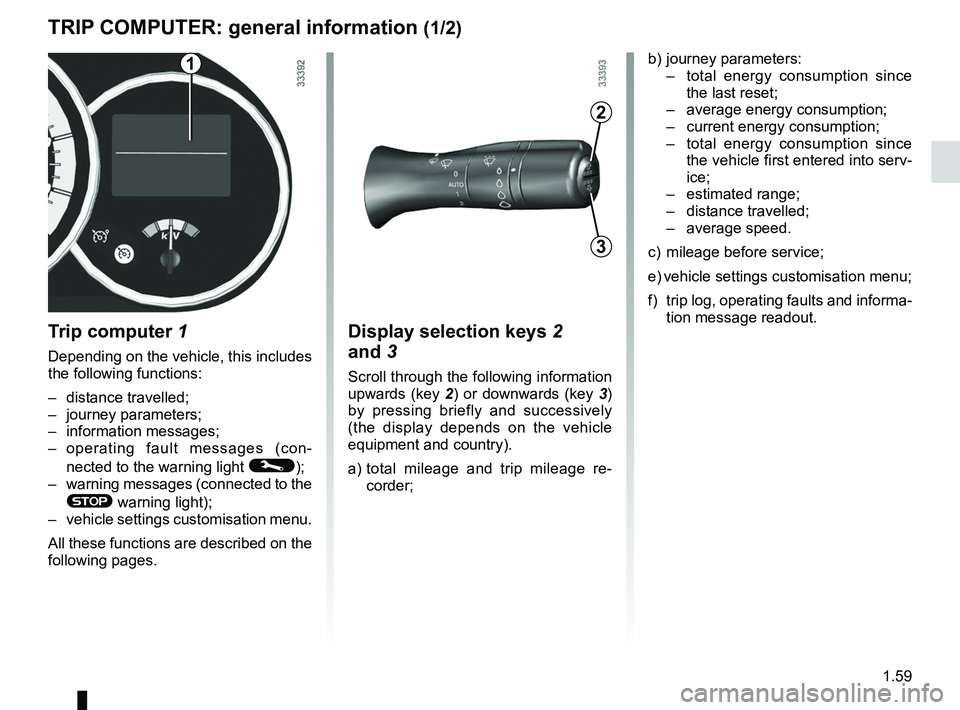
trip computer and warning system........(up to the end of the DU)
control instruments ............................... (up to the end of the DU)
indicators: instrument panel ............................. (up to the end of the DU)
instrument panel ................................... (up to the end of the DU)
warning lights ........................................ (up to the end of the DU)
instrument panel messages ..................(up to the end of the DU)
1.59
ENG_UD23015_2
Ordinateur de bord : généralités (L38 électrique - Renault)\
ENG_NU_914-4_L38e_Renault_1
Trip computer
triP cOmPUter: general information (1/2)
t rip computer 1
Depending on the vehicle, this includes
the following functions:
– distance travelled;
– journey parameters;
– information messages;
– operating fault messages (con -
nected to the warning light
©);
– warning messages (connected to the
® warning light);
– vehicle settings customisation menu.
All these functions are described on the
following pages.
Display selection keys 2
and 3
Scroll through the following information
upwards (key 2) or downwards (key 3)
by pressing briefly and successively
(the display depends on the vehicle
equipment and country).
a) total mileage and trip mileage re -
corder;
b) journey parameters:
– total energy consumption since
the last reset;
– average energy consumption;
– current energy consumption;
– total energy consumption since
the vehicle first entered into serv-
ice;
– estimated range;
– distance travelled;
– average speed.
c) mileage before service;
e) vehicle settings customisation menu;
f) trip log, operating faults and informa-
tion message readout.
3
2
1
Page 65 of 195

1.60
ENG_UD23015_2
Ordinateur de bord : généralités (L38 électrique - Renault)\
ENG_NU_914-4_L38e_Renault_1
triP cOmPUter: general information (2/2)
t rip mileage resetting
With “trip mileage recorder” selected on
the display, press button 2 or 3 until the
mileage recorder resets to zero.
resetting the journey
parameters (reset button)
with the display showing one of the
journey parameters, press button 2 or 3
until the display is reset.
reading energy consumption
values
Some vehicle equipment items con -
sume energy: the energy consumed
by the vehicle may therefore differ from
the energy consumed on the electric
counter.
interpreting some of the
values displayed after
resetting
The values showing average energy
consumption and average speed will
become more stable and reliable the
further you have travelled since the last
time the Reset button was pressed.
Automatic resetting of the
journey parameters
Resetting occurs automatically when
the maximum value of any of the pa -
rameters is exceeded.
3
2
Page 66 of 195

instrument panel messages..................(up to the end of the DU)
trip computer and warning system ........(up to the end of the DU)
instrument panel ................................... (up to the end of the DU)
1.61
ENG_UD25303_2
Ordinateur de bord : paramètres de voyage (L38 électrique - Renau\
lt)
ENG_NU_914-4_L38e_Renault_1
triP cOmPUter AND WArNiNg SYStem: journey parameters (1/4)
examples of selectionsinterpreting the display selected
a) total mileage and trip mileage recorder.
101778 km
112.4 km
Consumption
b) Journey parameters.
energy consumed since the last reset.
20 kWh
Average
Average energy consumption since the last reset.
The value is displayed after having travelled at least 400 metres since
the last reset.
18,5 kWh/100km
current energy consumption.
the display of information shown below DePeNDS ON the vehicle eqUiPmeNt AND cOUNtr
Y.
Page 67 of 195
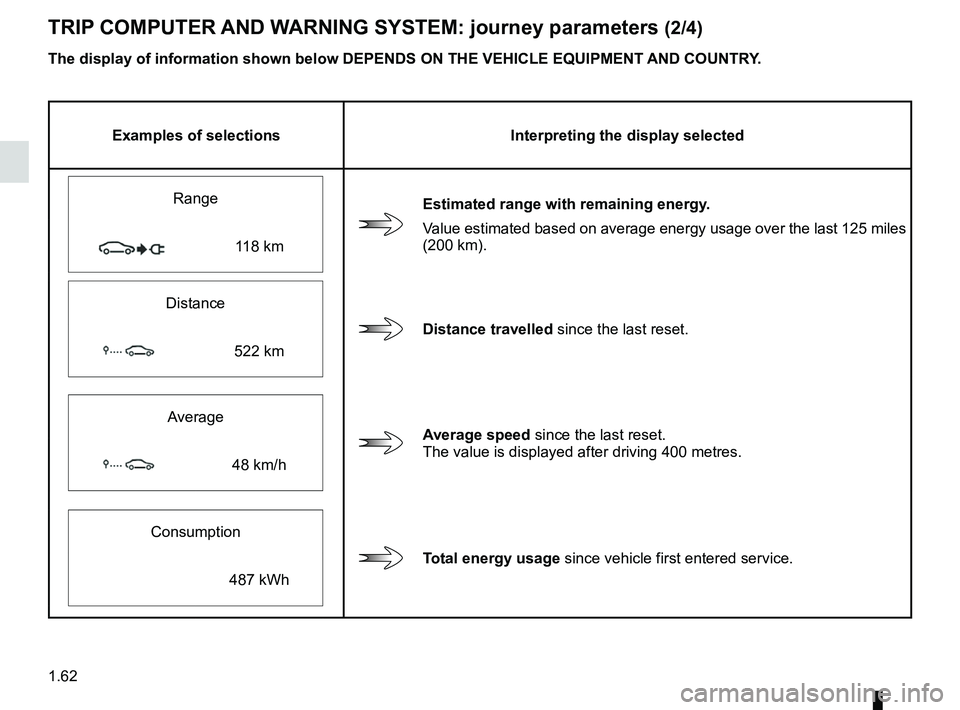
1.62
ENG_UD25303_2
Ordinateur de bord : paramètres de voyage (L38 électrique - Renau\
lt)
ENG_NU_914-4_L38e_Renault_1
Jaune NoirNoir texte
triP cOmPUter AND WArNiNg SYStem: journey parameters (2/4)
examples of selectionsinterpreting the display selected
Range
estimated range with remaining energy.
Value estimated based on average energy usage over the last 125 miles
(200 km).
118 km
Distance
Distance travelled since the last reset.
522 km
Average
Average speed since the last reset.
The value is displayed after driving 400 metres.
48 km/h
Consumption
t otal energy usage since vehicle first entered service.
487 kWh
the display of information shown below DePeNDS ON the vehicle eqUiPmeNt AND cOUNtr
Y.